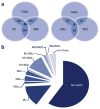The role of microglia and macrophages in glioma maintenance and progression
- PMID: 26713745
- PMCID: PMC4876023
- DOI: 10.1038/nn.4185
The role of microglia and macrophages in glioma maintenance and progression
Abstract
There is a growing recognition that gliomas are complex tumors composed of neoplastic and non-neoplastic cells, which each individually contribute to cancer formation, progression and response to treatment. The majority of the non-neoplastic cells are tumor-associated macrophages (TAMs), either of peripheral origin or representing brain-intrinsic microglia, that create a supportive stroma for neoplastic cell expansion and invasion. TAMs are recruited to the glioma environment, have immune functions, and can release a wide array of growth factors and cytokines in response to those factors produced by cancer cells. In this manner, TAMs facilitate tumor proliferation, survival and migration. Through such iterative interactions, a unique tumor ecosystem is established, which offers new opportunities for therapeutic targeting.
Conflict of interest statement
The authors declare no competing financial interests.
Figures






References
-
- Morantz RA, Wood GW, Foster M, Clark M, Gollahon K. Macrophages in experimental and human brain tumors. Part 2: studies of the macrophage content of human brain tumors. J Neurosurg. 1979;50:305–311. - PubMed
-
- Rossi ML, Hughes JT, Esiri MM, Coakham HB, Brownell DB. Immunohistological study of mononuclear cell infiltrate in malignant gliomas. Acta Neuropathol. 1987;74:269–277. - PubMed
-
- Hortega PDR. El tercer elemento de los centros nerviosos. Bol Soc Esp d Biol. 1919;9:69–120.
Publication types
MeSH terms
Grants and funding
LinkOut - more resources
Full Text Sources
Other Literature Sources

